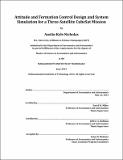| dc.contributor.advisor | David W. Miller and Jeffrey A. Hoffman. | en_US |
| dc.contributor.author | Nicholas, Austin Kyle | en_US |
| dc.contributor.other | Massachusetts Institute of Technology. Department of Aeronautics and Astronautics. | en_US |
| dc.date.accessioned | 2013-11-18T20:41:32Z | |
| dc.date.available | 2013-11-18T20:41:32Z | |
| dc.date.copyright | 2013 | en_US |
| dc.date.issued | 2013 | en_US |
| dc.identifier.uri | http://hdl.handle.net/1721.1/82488 | |
| dc.description | Thesis (S.M.)--Massachusetts Institute of Technology, Dept. of Aeronautics and Astronautics, 2013. | en_US |
| dc.description | This electronic version was submitted and approved by the author's academic department as part of an electronic thesis pilot project. The certified thesis is available in the Institute Archives and Special Collections. | en_US |
| dc.description | Cataloged from department-submitted PDF version of thesis | en_US |
| dc.description | Includes bibliographical references (p. 113-115). | en_US |
| dc.description.abstract | Spacecraft formation flight has been identified as a critical enabling technology for achieving many scientific, commercial, and military objectives. One of the primary challenges of a formation flight mission is the control of the relative motion between spacecraft. Before any flagship missions will launch, technology development missions will be required to demonstrate the utility and functionality of formation flying systems. This thesis describes the complete attitude and formation control design for the MotherCube formation flight technology demonstration mission in LEO. A model of the spacecraft's sensors and actuators is developed and analyzed. Using curvilinear orbit theory, a simple LQR control law is used to generate a set of desired relative accelerations for formation control. A newly developed two-tier numerical allocation scheme is used alongside an independent PD attitude control law to generate a set of actuator commands which provides 3-axis attitude stabilization as well as formation control with guaranteed feasibility of actuator commands. An Extended Kalman Filter was developed to estimate the system attitude and angular rate from sensor measurements. To test these algorithms, a simulation environment was developed. This environment includes realistic models of space environment and the major perturbation effects which a LEO spacecraft formation would encounter. In order to improve the fidelity, a new intermediate-accuracy method for computing attitude-dependent aerodynamic and solar effects was also developed. Finally, results from the simulation are used numerically validate the dual-allocator approach, assess the performance of the control laws and provide system level metrics such as fuel use and required maneuver time. | en_US |
| dc.description.statementofresponsibility | by Austin Kyle Nicholas. | en_US |
| dc.format.extent | 115 p. | en_US |
| dc.language.iso | eng | en_US |
| dc.publisher | Massachusetts Institute of Technology | en_US |
| dc.rights | M.I.T. theses are protected by
copyright. They may be viewed from this source for any purpose, but
reproduction or distribution in any format is prohibited without written
permission. See provided URL for inquiries about permission. | en_US |
| dc.rights.uri | http://dspace.mit.edu/handle/1721.1/7582 | en_US |
| dc.subject | Aeronautics and Astronautics. | en_US |
| dc.title | Attitude and formation control design and system simulation for a three-satellite CubeSat mission | en_US |
| dc.type | Thesis | en_US |
| dc.description.degree | S.M. | en_US |
| dc.contributor.department | Massachusetts Institute of Technology. Department of Aeronautics and Astronautics | |
| dc.identifier.oclc | 862234350 | en_US |
